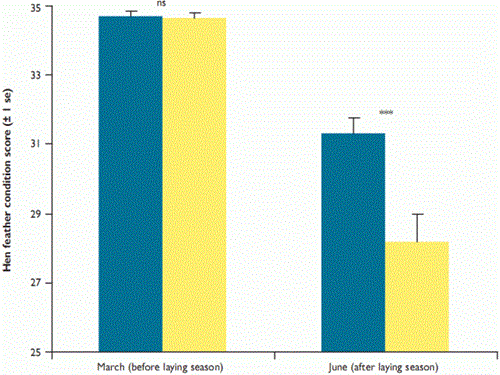 Plastic devices known as spectacles (or specs) are often fitted onto the beak of birds to reduce feather pecking, cannibalism and egg eating by pheasants in laying pens. These mask the bird’s forward vision and are attached to the beak by clipping into the nostrils without piercing the septum. Spectacles are fitted to the birds when they are placed in the laying pens (during February/March) and removed just before release into the wild after the laying season (in June/July). As part of a series of studies looking into the welfare effects of anti-feather pecking devices in pheasants, we examined the effect of spectacles on the physiology and behaviour of pheasants in flock-laying pens on game farms across England.
Plastic devices known as spectacles (or specs) are often fitted onto the beak of birds to reduce feather pecking, cannibalism and egg eating by pheasants in laying pens. These mask the bird’s forward vision and are attached to the beak by clipping into the nostrils without piercing the septum. Spectacles are fitted to the birds when they are placed in the laying pens (during February/March) and removed just before release into the wild after the laying season (in June/July). As part of a series of studies looking into the welfare effects of anti-feather pecking devices in pheasants, we examined the effect of spectacles on the physiology and behaviour of pheasants in flock-laying pens on game farms across England.
In 2006 and 2007, we collected data from 15 game farms. On each farm, we randomly allocated a treatment to two pens, where birds either wore spectacles or did not. Management was according to normal practice on each farm and was identical for each treatment apart from the use of spectacles. We assessed the body, feather and skin condition of pheasants in each treatment pen before and after the laying season. We also noted any abnormalities of the bill or nostrils and signs of disease. We recorded data on mortality, feeding and egg production through the laying season. Each week we assessed the behaviour of spectacled and non-spectacled pheasants.
Figure 1: The mean feather condition score of hen pheasants in 12 spectacled and non-spectacled laying chicks on game farms across England, 2006 and 2007

ns = not significant; *** = P <0.001
The body mass index (weight divided by tarsus length) of cocks and hens was not affected by the fitting of spectacles. Incidences of skin damage in both cocks and hens were lower in the spectacled pens. The use of spectacles reduced the prevalence of skin damage from 13% to 3% in cocks and from 42% to 23% in hens. Spectacles also reduced feather damage in hens (see Figure 1), but not significantly in cocks (see Figure 2). However, we found that incidences of bill and nostril damage in spectacled hens were over four times higher than whose without spectacles (see Table 1). Incidences of bill damage did not differ between spectacled and non-spectacled cocks. There was little difference in mortality rates between spectacled and non-spectacled pens; this was the case for both cocks and hens. Egg production, egg weights and feed intake were also similar between spectacled and non-spectacled pens.
Table 1: The mean percentage of spectacled and non-spectacled pheasants with bill or nostril abnormalities in paired pens before (March) and after (June) the laying season on game farms across England, 2006 and 2007
| |
Cocks |
Hens |
| Treatment |
|
March |
|
|
June |
|
|
March |
|
|
June |
|
| |
Number |
Mean |
se |
Number |
Mean |
se |
Number |
Mean |
se |
Number |
Mean |
se |
| Spectacled |
10 |
2.5 |
2.0 |
10 |
9.9 |
4.8 |
12 |
2.4 |
0.9 |
12 |
12.9 |
4.2 |
| Non-spectacled |
10 |
1.8 |
1.2 |
10 |
4.3 |
2.4 |
12 |
2.3 |
0.7 |
12 |
3.1 |
1.1 |
| Significance |
|
ns |
|
|
ns |
|
|
ns |
|
|
*** |
|
Although spectacles had no effect on the behaviour of cocks, hens fitted with spectacles behaved differently compared with those without. In particular, spectacles reduced pecking of other birds, perching and foraging, and increased head shaking/scratching and feeding.
Unlike bits, which prevent birds from grasping feathers, spectacles are designed to reduce feather pecking in pheasants by blocking their forward vision. This study suggests that although spectacles do help prevent birds pecking other birds, the reduction in the birds’ field of vision also reduces the ability of hens to feed, and forage. Although spectacled hens foraged less than non-spectacled hens, they were observed feeding from hoppers more. By impairing the ability of hens to direct peck at individual food items, spectacles may reduce the feeding efficiency of hens and therefore increase the time they must spend feeding to meet their dietary requirements. Despite this effect on feeding behaviour, overall food consumption and body mass index did not differ between spectacled and non-spectacled birds. The provision of perches that are easily accessible by being low to the ground and having a large surface area, such as straw bales, could increase perching by spectacled birds.
Although the results of this study show that spectacles can improve feather and skin condition in pheasants, these benefits may be undone by the damage they can cause to the bill and nostrils of hens. Therefore, consideration should be given to redesigning spectacles to prevent this problem occurring.
Figure 2: The mean feather condition score of cock pheasants in 12 spectacled and non-spectacled laying flocks on game farms across England, 2006 and 2007

ns = not significant; *** = P <0.001
Get the Latest News & Advice
Join over 100,000 subscribers and stay updated on our latest advice, research, news and offers.
*You may change your mind any time. For more information, see our Privacy Policy.